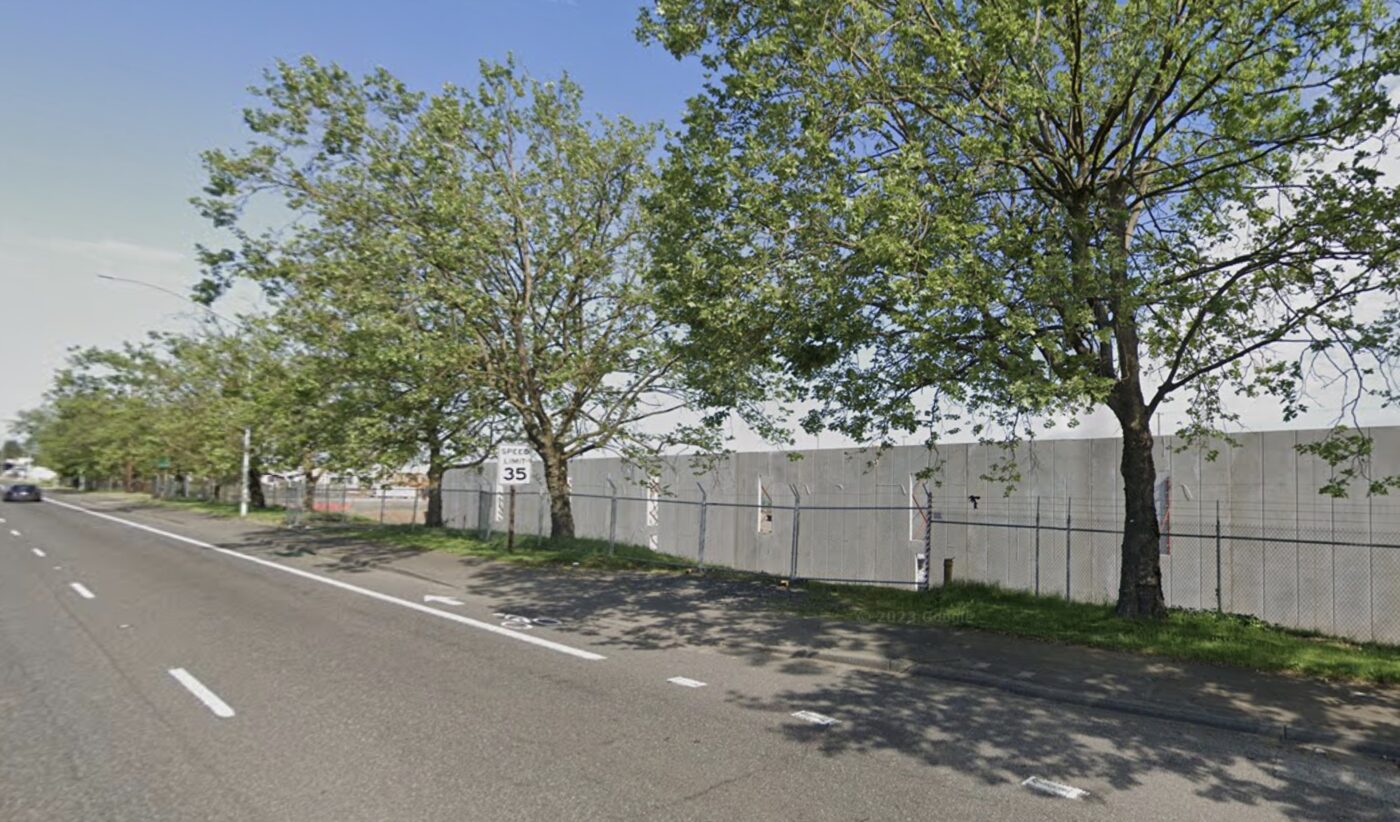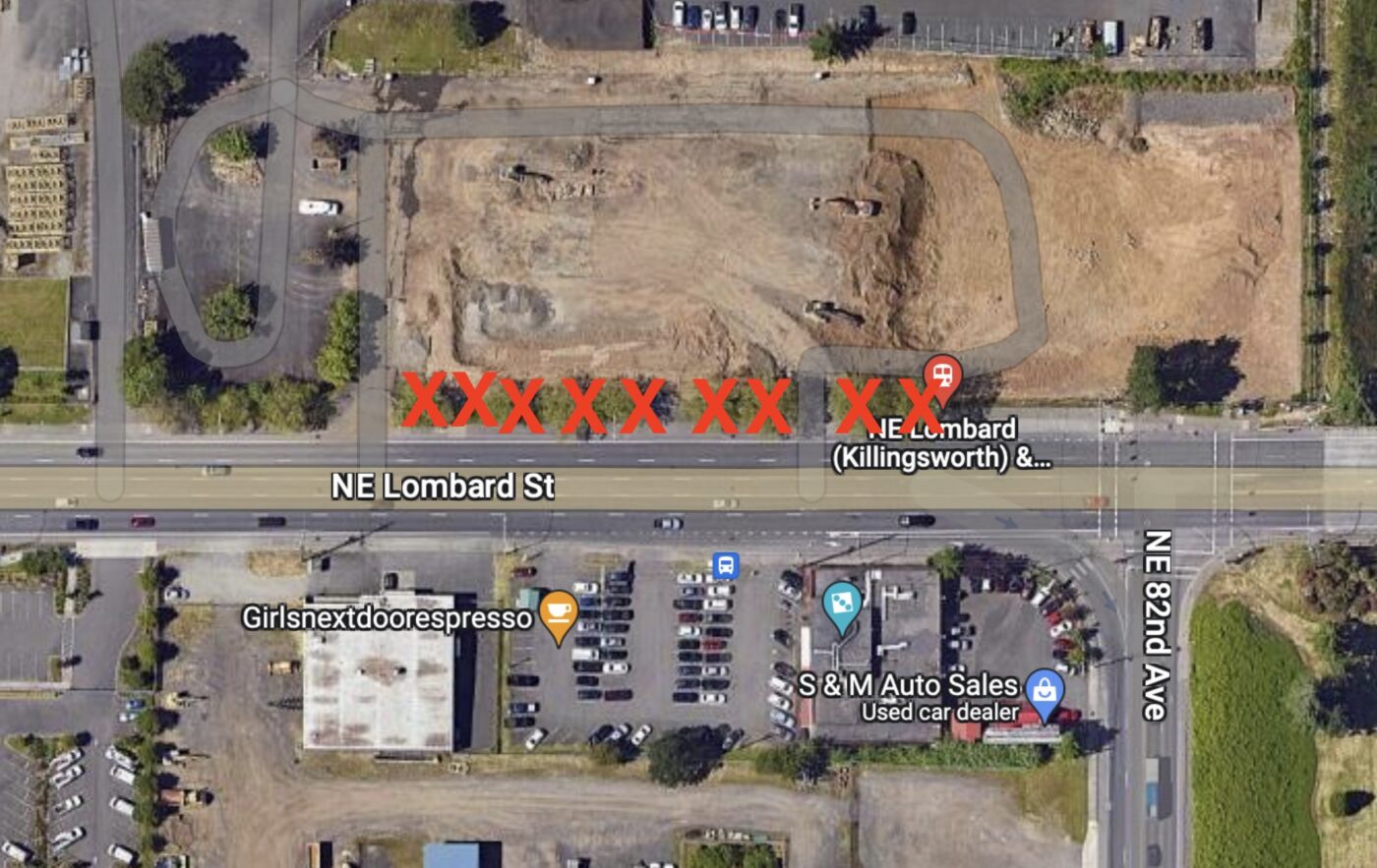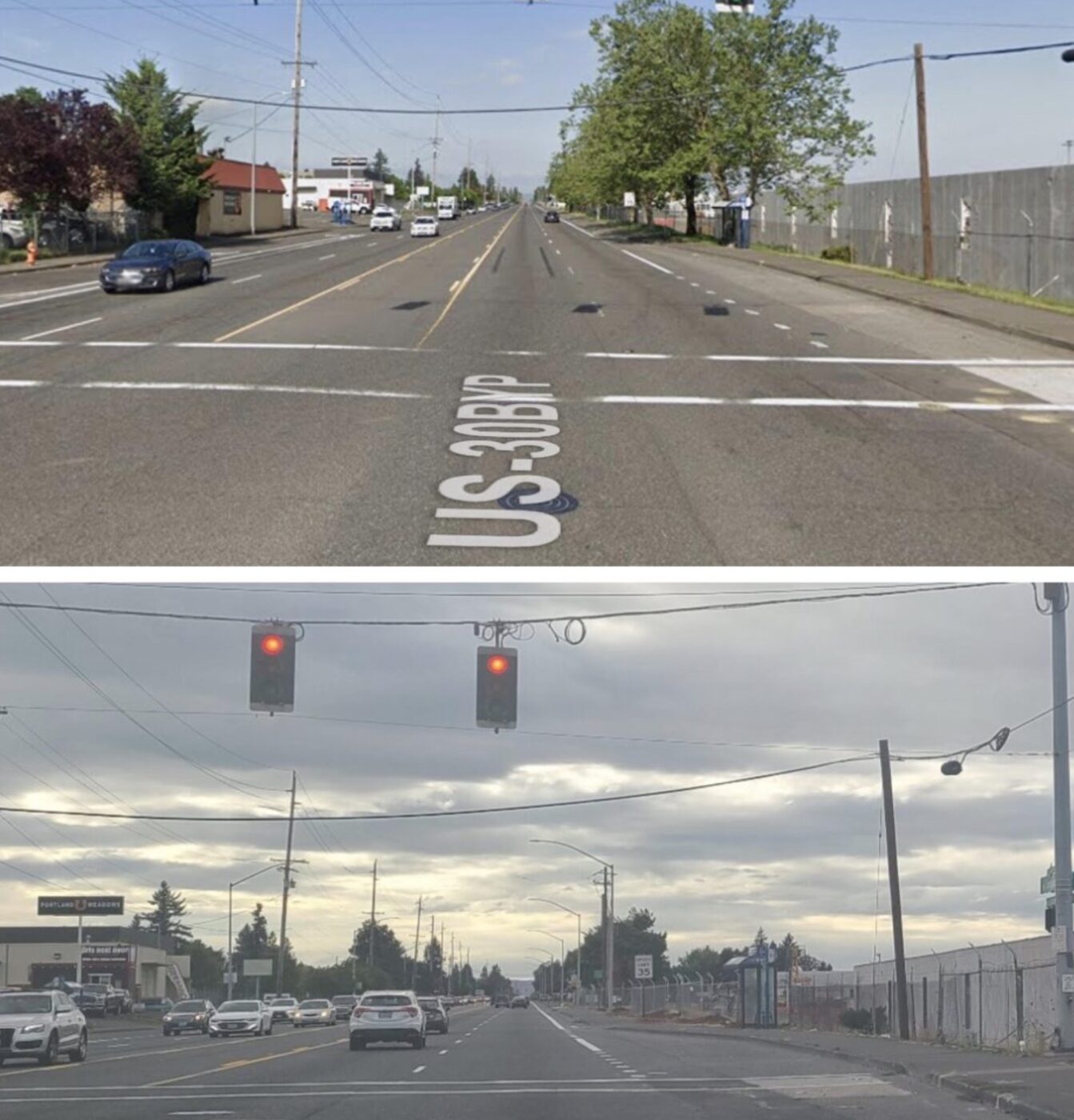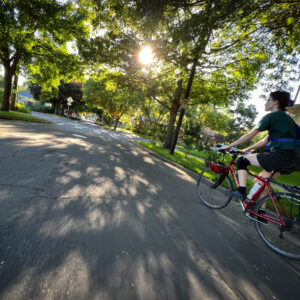A row of large street trees on Northeast Lombard have been cut down, robbing the street of an important source of shade, traffic calming and myriad other benefits.
A reader tipped off BikePortland to the removal and shared a photo that shows around eight mature trees are now gone. The trees were planted in pairs across a 420-foot expanse adjacent to a sidewalk on the north side of Lombard west of 82nd Avenue (map) and they were adjacent to an industrial property (8121 NE Lombard) that is currently being redeveloped.
According to our tipster, the trees were ground down to stumps earlier this month.
The City of Portland Urban Forestry Office, says that since Lombard is part of Highway 30 and is managed and owned by the Oregon Department of Transportation, the construction permit is exempt from the chapter in Portland’s tree code that would have allowed the city to review the plans and possibly spare the trees
Chapter 11.05.040 (C) of Portland’s Tree Code states:
State or Federal jurisdiction. Trees within public rights-of-way that are managed by the State of Oregon are exempt from the regulations of this Title… However, these trees may be subject to other City regulations or Intergovernmental Agreements. Furthermore, the City retains summary abatement authority for nuisances posing an immediate threat to public safety.
When our tipster shared the news with the staffer at Urban Forestry, they said, “I am sorry to hear of this removal and understand how frustrating tree loss is for the community.”
Reached for comment, a spokesperson from the Oregon Department of Transportation told BikePortland the trees were a City of Portland matter.
This is just the latest bad news for street trees in Portland. A story in the Portland Mercury in August shared how City of Portland bureaucracy and “inter-bureau power struggles” have coupled with a warmer climate to “make it more difficult for Portland’s tree canopy to thrive as it used to.”
Street trees are also an equity issue because of how the benefits of a strong tree canopy are not evenly spread citywide. The location of this latest removal on Lombard is in a census tract that scores in the highest level on PBOT’s Equity Matrix. PBOT’s plans for nearby 82nd Avenue
I’ve asked PBOT for comment and will update this post if/when I hear back.










Thanks for reading.
BikePortland has served this community with independent community journalism since 2005. We rely on subscriptions from readers like you to survive. Your financial support is vital in keeping this valuable resource alive and well.
Please subscribe today to strengthen and expand our work.
This area has gotten worse for walking and riding lately in part because the casino that opened across the street often doesn’t have enough parking and people tend to park their cars in the bike lane and on the sidewalk. With the removal of these trees the bus shelter has now also lost the afternoon shade that they provided. Unfortunately everything about the way that ODOT manages what was Killingsworth but is now Lombard says you shouldn’t come here without a car.
I would encourage you to go to Portland maps, and review the approved site plan. The planting plan will eventually increase the total number of trees along this portion of the corridor. Particularly near the bus stop. The long term plan is better than what is currently there. Also, the photos taken towards the meadows sign are not related to the development mentioned in the article.
Interesting Jeremy. I’ll take a look at that.
It is great to hear that just a decade or two from now we might be back to where we were but it is certainly much much worse in the shorter term. I am less concerned about this exact spot though and more concerned with the idea that no one thinks they are in charge of protecting street trees along ODOT managed roads.
all of the so-called street trees were planted, and actually become a nuisance when they get larger, breaking up pavement and knocking down powerlines.
I don’t think you are familiar with this location, there are no power lines running along Lombard on the section where these trees were removed. While some trees have roots that can cause issues many trees have no such problems. These trees were large and mature and there is no lifting or damage to the sidewalk.
Street trees also obscure sightlines for all roadway users.
But I guess all of that is convenient to overlook in favor of other narratives.
How do they obscure sightlines?
I just looked at the plans. You’re right, there will be several new trees, including several large ashes (100′ h x 100′ wide at maturity for that type of tree, according to the plans).
The thing that’s strange to me is that C1.10B Existing Conditions and Demo Plan only shows 3 street trees on Lombard (strangely called out as NE Killingsworth), all at the west end of the project. None of the several trees east of those are shown. Plus, the three shown look like they were cut down also, if I’m reading the article photos correctly.
So it’s great there will be new landscaping, but the question remains why existing trees were not shown on the “existing conditions” plan. It’s a question for Mackenzie (the architect/engineer) and owner. If it was legitimate to cut them down, that still doesn’t mean it was legitimate to hide their existence, which if I’m understanding the plans correctly may have been done (another reason it would be nice to hear from the consultants rather than me speculating and possibly misunderstanding).
One might question the choice of selecting ash trees for the replacement trees. The emerald ash borer is an introduced pest that has recently been found in Oregon and is expected to devastate our existing native and ornamental ash trees in the coming years.
https://extension.oregonstate.edu/collection/emerald-ash-borer-resources
That section of Lombard was called Killingsworth until about a year ago when the name was changed.
It’s hard to tell from the street view, but it looks like these may be Norway maples, which are listed as nuisance trees by the City of Portland. I am absolutely rabid about tree protection, but if the developers do have a plan to plant better trees at least that is somewhat comforting. Hopefully they will plant a variety of species and not just ash trees because of the threat of the Emerald Ash Borer.
Actually, the city’s tree inventory website lists these as London plane trees: https://www.portland.gov/trees/get-involved/treeinventory
According to the planting plans, they will be planting a mix of types of trees, and they’re in a deep landscaped area running the length of the site. Overall it could be an improvement over having just the existing street trees.
But the questions still remain:
1) Is it really true that the applicable regulations would not require street trees to be kept, or replaced if not kept, and that no permit was needed from the City to remove them?
2) If all that is true, WHY don’t the regulations require all that? and
3) Why weren’t the street trees shown on the existing conditions plan (and did that interfere with the review process)?
This is just the latest bad news for people trying to figure out who is responsible for various pieces of city infrastructure. It seems that the city, state, and county aren’t really sure who owns anything when those things cross over between them.
I was involved in 2015 with pushing back on ODOT’s planned removal of 26 mature street trees on another state highway in the city, part of the “Powell Boulevard Safety Project” (from 20th to 34th Ave.). There was confusion, and obfuscation, then too over who had jurisdiction over the trees. The City Attorney got involved, and it was determined that the City of Portland had jurisdiction, and Title 11 regulations did apply. See attached screenshot of the official communication.
I share this so other tree advocates can be aware of this precedent. I can provide additional documentation on this advocacy struggle. If anyone needs it, please contact me.
Mostly that shade has been keeping cars cool because people park there on the sidewalk all the time when the Portland Meadows lot gets full across the street.
So no one had to pull any permit for the tree cutting?
does that mean ODOT owned roadways, it is free for the public to cut down trees?
Are you serious? Have you not seen all the ODOT property that is occupied by vagrants? Just look at any off ramp. ODOT owned roadways are free to do anything. If you want some help taking trees from ODOT to your property, I got a strong back.
https://www.reddit.com/r/treelaw/
Hey, JM…it looks like trees were cut on BOTH sides of the street. (I assume by different property owners.)
And is Portland an official awarded: “Tree City USA”?
This is the way it is going. The Governor’s housing task force’s first recommendation was to exempt developers from most Tree Code restrictions on cutting down larger trees.
Plenty of people on this forum oppose stricter rules protecting trees. It’s just sad.
Even the city of Portland/POBT doesn’t seem to care about our trees or environment. It’s really discouraging.
https://www.wweek.com/news/2023/08/09/trees-planted-by-the-city-in-east-portland-two-years-ago-are-dead-because-the-city-didnt-water-them/
Conservative people delite in cutting down trees; especially rich conservative developers. Do we have to sell our souls to some overweight out-of-state big wig in order to survive? People have survived for tens of thousands of years but now all of a sudden we have to live in a barren wasteland and be beholden to someone rich and vie for their approval so we can work for them. Doesn’t sound like a world I want to live in.
Depends, how are they protecting them?
A number of years ago the City had a committee of arborists and yard maintenance types rewrite the rules about what was allowed and not allowed for the private home owner.
So what used to be a yearly chore of mine to cut back limbs on my trees was by City code a way for arborists to profit as I would need to contact one before I did.
As a result I’ve stopped planting new trees on my properties. Yes, I’m a rebel and still cut them back every year (been doing it for 30+ years now), but I realize a nasty neighbor could turn me in and I’d get fined.
Before those codes became rules I was planning to plant more trees in my yard as I like shade, but not when those trees became the “property” of the City and I no longer was allowed to do what I need to with them.
I’m all for rules around the complete removal of trees, but the rules that came into place restricting what I could do to my own trees and large bushes was just too much.
“how are they protecting them?”
Not letting builders clear cut their lots and street trees would be a start. Trees were a lot more protected until fairly recently. The rules changed at just about the same time folk started wringing their hands about the loss of tree cover.
“sweltering in the blazing sun to own the libs”
I feel you on the frustration regarding the changes to tree codes etc. Those limbs on your trees aren’t the only thing over reaching their appropriate boundaries. Lol
I just hope you don’t arbor too much resentment about it all. 😉
I guess it’s a tough issue because on one hand, it’s really important to protect the trees that already exist and provide shade where we need it. However, if the city or county make it harder to cut down trees for new housing development, that development either doesn’t happen, or gets pushed to the periphery where it consumes farmland, forest, or wetlands. Save 1 tree but lose a dozen somewhere else.
It’s a classic trolley problem I suppose. Except there’s no trolleys anymore, just 8 lanes of asphalt lol
It’s the classic false binary.
I’m sorry, but this EXACTLY the kind of nonsense from you guys that needs to stop. Yes, it’s a shame the trees couldn’t be saved, but barring incentives for a developer to keep the trees (which I rarely ever see anyone propose), the alternatives are:
a.) The community loses economic activity altogether, leading people to leave (in the long-term if not immediately), often for:
b.) Greenfield economic activity somewhere in even more car-dependent sprawl.
Yes, one could say this area already is car-dependent sprawl, but it’s near a MAX station and it’s relatively near downtown. That means it’s ripe for denser redevelopment–for either housing or jobs–and better integration into the economic center of the region.
When I think of Portland, I think of the whole metro area, and that’s what you need to do to avoid coordinate economic development to minimize environmental impacts; otherwise redevelopment just happens in more consumptive, less productive places, like the sprawl that exists in basically every direction outside of downtown. This isn’t even like a new cannard for NIMBYist thought, either. I forget where I saw it, but someone said you can have either sprawl (and destroy even more trees, somewhere else) or upzoning (which this counts as), or you can have economic stagnation.
Just because I can’t not use this idiom here: don’t miss the forest for the trees.
Or they could have just left the trees, the building is set well back from the property line, the tree removal certainly wasn’t required to make room for the new building.
I do not accept the premise that our choice is either urban sprawl or cut down all the trees.
This sounds like a valid comment for cases–that certainly do exist–where projects face onerous requirements that create massive costs or restrictions to what people can do on their private property.
But here? This is about trees on public property NEXT to the project. Unless the owner has owned this parcel for decades, the trees were there when they bought it. And the owner is the largest general contractor headquartered in the PNW, with (in 2017) $1.4 billion in revenues and nearly 1,000 employees, that gets a substantial amount of its revenue from public work.
Why would you expect that owner (or any for that matter) to receive incentives to not cut down trees on public property next to their site?
Further, in the City’s recent survey of developers asking them what they viewed as the main impediments to building housing in Portland, did requirements to plant street trees even appear among the responses? And in this case, we’re not even talking about that–we’re talking only about not cutting down street trees that are already there. So even developers don’t view maintaining street trees as any sort of onerous requirement.
I call BS on your point, aquaticko. You are setting up an either-or false dilemma: it’s not the case that a developer has to forgo development if he has to save a few trees. In fact, all of the really desirable places to live manage to have trees AND development. Look at Lake Oswego, which has very strong rules for protecting trees, yet they have some of the most expensive and sought-after real estate in Oregon.
What’s clear from this article – and many others on BP – is that ODOT is like a cancer running through Portland and other cities. On the streets ODOT manages, ODOT always ensures that cars are dominant, pollution is rampant, nature is subjugated, and safety always takes a back seat to vehicle speed and throughput.
ODOT is truly horrible about planting trees. They actively prevent new tree planting by requiring ridiculous setbacks from driveways/intersections based in vision cones for high speed roads- also the road down and fit more trees in! They are also very resistant to planting trees in medians and ramps along freeways- all the renderings for the rose quarter are BS! ODOT maintenance gets the final say, and they want no trees, or trees planted on 75′ centers
Aquaticko makes the absurd and misinformed, knee jerk assumption that removing a row of street trees would somehow benefit housing or employment in the city, and that it was essential to remove the trees to allow this site to redevelop. Both of these assumptions are flat out false and misleading.
This site is being redeveloped as a construction equipment and material storage site. The planned use is the opposite of dense redevelopment (though a construction material storage area within the confines of the city will undoubtedly hello to facilitate redevelopment elsewhere in the city, modest constraints on the site to preserve trees in the right off way would not be a deal breaker). It is not going to provide housing, and if the development had been required to set back a few feet to preserve the street trees, it would have had zero impact on the employment potential of the site. It clearly was not necessary to remove street trees to make site development possible.
I can’t tell if the post I’m responding to is a parody or if they actually believe that preserving a couple of street trees would actually have had an impact on site development. I suspect the latter, given the current tone and mindset that has overtaken both political parties in this state, which is sad.
Whoever the property owner is over there has now pissed off a lot of Portlanders due to this action.
They could’ve easily pulled and transplanted those trees in a multitude of different areas of the city. What a POS!
*** Moderator: deleted last sentence, profanity. ***
Hey, anonymous moderator (Maus? Caballero?)–what’s wrong with a little effing profanity? Couldn’t you just bowdlerize it if you must?
I hear you Matt, I swear like a sailor. But there are certain sexual images I don’t want to be confronted with.over my morning coffee. Plus, this was a contrived pasted-on bit of sophmoricism that didn’t naturally flow from the language of the comment. There is an art to using off-color language and this didn’t pass.
Fair enough–from the only description being “profanity”, I imagined it was a just casual four-letter word thrown in for emphasis. Perhaps you could be be a little more specific in the moderator message next time, such as “deleted last sentence due to graphic sexuality”. That would be helpful in letting us learn what is and isn’t acceptable on here.
Yeah, sometimes I struggle to come up with words to describe what I’m deleting. I wasn’t satisfied with “profanity,” but also didn’t want to spend a bunch of time on it.
Maybe quote the exact wording of what was deleted so there’s no ambiguity as to what’s unacceptable.
Cotw
Those 30ft mature trees can be “easily” moved? By you? Define easily.
I don’t understand the last sentence….
Thanks for talking about this! It should be sooo much harder to remove mature trees at this point. Shade is the easiest and most potent way to cool the city. A place like Portland losing tree canopy year after year is just illogical and heartbreaking.
I totally agree; and that political forces are working to increase this tree canopy loss at both the city and state levels is just depressing.
Add to that that these look like they were street trees on public property. (They were in from the inside edge of the sidewalk, and usually the property line is at the sidewalk edge. But on the site plan, it looked like the property line is in a few feet from the sidewalk, and in the photo, the construction fence is set inside of the trees, where the site plan shows the property line.)
So the main reason why people want to cut down trees for development is that they’re in the way. That doesn’t apply for street trees on public property, unless they happen to be where something like a driveway needs to go.
And in fact, not only were these not in they way of any new driveways, the new building (gray wall in photo) is so far back from the trees that even their extending branches wouldn’t have interfered with it.
And the fact that sometimes there really are valid reasons for developers wanting to cut down trees on their properties means that it’s that much more important to preserve trees that aren’t causing major interferences, which looks to be the case here.